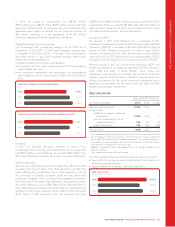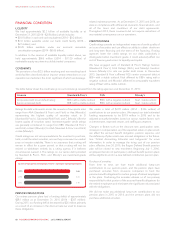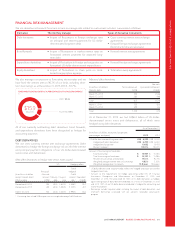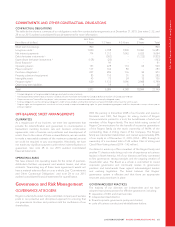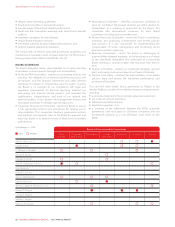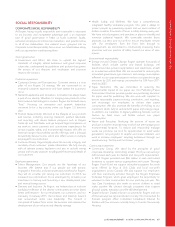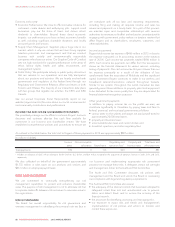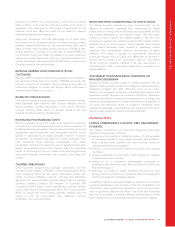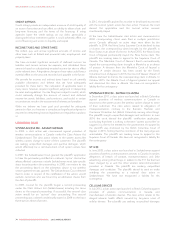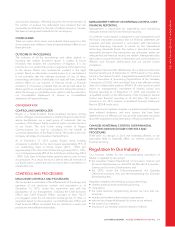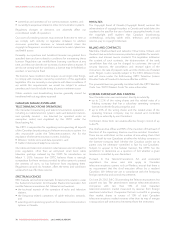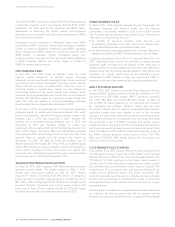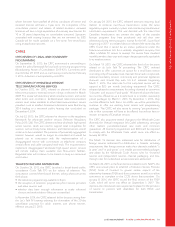Rogers 2015 Annual Report Download - page 71
Download and view the complete annual report
Please find page 71 of the 2015 Rogers annual report below. You can navigate through the pages in the report by either clicking on the pages listed below, or by using the keyword search tool below to find specific information within the annual report.
MANAGEMENT’S DISCUSSION AND ANALYSIS
• our business continuity and disaster recovery plans;
• any special audit steps adopted due to material weaknesses or
significant deficiencies that may be identified; and
• other risk management matters from time to time as determined
by the Audit and Risk Committee or directed by the Board.
ENTERPRISE RISK MANAGEMENT
Our Enterprise Risk Management program uses the “3 Lines of
Defence” framework to identify, assess, manage, monitor, and
communicate risks. Our business units and departments, led by the
Executive Leadership Team, are the first line of defence and are
accountable for managing or accepting the risks. Together, they
identify and assess key risks, define controls and action plans to
minimize these risks, and enhance our ability to meet our business
objectives.
Enterprise Risk Management is the second line of defence.
Enterprise Risk Management helps management identify the top
risks to meeting our business objectives, our risk appetite, and
emerging risks. At the business unit and department level,
Enterprise Risk Management works with management to provide
governance and advice in managing the key risks and associated
controls to mitigate these risks. Enterprise Risk Management works
with Internal Audit to monitor the adequacy and effectiveness of
the controls to reduce risks to an acceptable level.
Enterprise Risk Management carries out an annual strategic risk
assessment to identify our principal risks to achieving our corporate
objectives by identifying business unit- and department-level risks
and aligning the business unit and department objectives to the
corporate objectives. Using an aggregate approach, Enterprise Risk
Management identifies the top risks and their potential impact on
our ability to achieve our corporate objectives. This assessment
includes reviewing risk reports, audit reports, and industry
benchmarks and interviewing senior management with business
unit and department accountability. Enterprise Risk Management
reports the results of the annual strategic risk assessment to the
Executive Leadership Team, the Audit and Risk Committee, and the
Board.
Internal Audit is the third line of defence. Internal Audit evaluates
the design and operational effectiveness of the governance
program, internal controls, and risk management. Risks, controls,
and mitigation plans identified through this process are
incorporated into the annual Internal Audit plan. Annually, Internal
Audit also facilitates and monitors management’s completion of
the financial statement fraud risk assessment to identify areas of
potential fraud or misstatement in our financial statements and
disclosures and to ensure these controls are designed and
operating effectively.
The Executive Leadership Team and the Audit and Risk Committee
are responsible for approving our enterprise risk policies. Our
Enterprise Risk Management methodology and policies rely on the
expertise of our management and employees to identify risks and
opportunities and implement risk mitigation strategies as required.
RISKS AND UNCERTAINTIES AFFECTING OUR
BUSINESS
This section describes the principal risks and uncertainties that
could have a material adverse effect on our business and financial
results. Any discussion about risks should be read in conjunction
with “About Forward-Looking Information”.
GENERAL RISKS
ECONOMIC CONDITIONS
Our businesses are affected by general economic conditions and
consumer confidence and spending. Recessions, declines in
economic activity and economic uncertainty can erode consumer
and business confidence and reduce discretionary spending. Any
of these factors can negatively affect us through reduced
advertising, lower demand for our products and services,
decreased revenue and profitability, and higher churn and bad
debt expense. A significant portion of our broadcasting,
publishing, and digital revenue comes from the sale of advertising.
Poor economic conditions can also have an impact on our pension
plans because there is no assurance that the plans will be able to
earn the assumed rate of return. Capital market volatility may result
in changes in the discount rates and other variables used to
calculate our pension obligations, requiring us to make
contributions in the future that differ significantly from current
contributions and assumptions being used in the actuarial valuation
process.
SUBSTANTIAL COMPETITION
There is no assurance that our current or future competitors will not
provide services that are superior to ours or at lower prices, adapt
more quickly to evolving industry trends or changing market
requirements, enter markets we operate in, or introduce
competing services. Any of these factors could reduce our business
market share or revenue, or increase churn.
We may have some ongoing re-pricing of products and services
with our existing subscribers as we may need to extend lower
wireless pricing offers to attract and retain customers. As wireless
penetration of the population deepens, new wireless customers
may generate lower average monthly revenue and this could slow
revenue growth.
Wireless could face increased competition due to recent changes
to foreign ownership and control of wireless licences:
• foreign telecommunication companies could enter the
Canadian market by acquiring wireless licences or a holder of
wireless licences. If companies with significantly greater capital
resources enter the Canadian market, it could reduce our
wireless market share. See “Foreign Ownership and Control” for
more information.
• ISED Canada’s policy regarding the transfer of spectrum
licences, combined with 2012 legislation that allows foreign
ownership of wireless providers with less than 10% market share,
2015 ANNUAL REPORT ROGERS COMMUNICATIONS INC. 69


